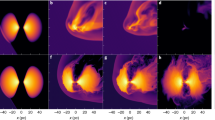Abstract
OBSERVATIONS of elliptical galaxies show a positive correlation1,2 between total luminosity and core radius, defined as the radius at which surface luminosity becomes half of the central value. This has been taken as evidence against the idea that ellipticals are the result of galaxy mergers, because in simulated mergers3–5 the core radius remained almost constant. In those simulations, the galaxies contained no central black holes, but there is a body of evidence to suggest that such black holes are common in ellipticals6. Here, we present simulations of the merging of identical galaxies with and without central black holes, and find that when black holes are included, the merged galaxy acquires an isothermal core comparable in mass to the sum of the two initial black holes. Furthermore, the ratio of the core radius to the half-mass radius is approximately the same as the ratio of the black hole mass to the total galaxy mass, a result also consistent with observational evidence. These results, which can be understood by means of simple analytical arguments, suggest that most elliptical galaxies contain central black holes with masses comparable to the mass of their cores.
Similar content being viewed by others
References
Kormendy, J. Astrophys. J. 295, 73–79 (1985).
Lauer, T. R. Astrophys. J. 292, 104–121 (1985).
Farouki, R. T., Shapiro, S. L. & Duncuan, M. J. Astrophys. J. 265, 597–605 (1983).
Barnes, J. E. Astrophys. J. 331, 699–717 (1988).
Okumura, S. K., Ebisuzaki, T. & Makino, J. Publs Astr. Soc. Japan 43 (in the press).
Dressler, A. lAU Symp No. 134, Active Galactic Nuclei (eds Osterbrock, D. E. & Miller, J. S. 217–232 (1989).
Toomre, A. & Toomre, J. Astrophys. J. 178, 623–666 (1972).
Toomre, A. Evolution of Galaxies and Stellar Populations (eds Tinsely, B. M. & Larson, R. B.) 401–426 (Yale Observatory, New York, 1977).
Schweizer, F. Astrophys. J. 252, 455–460 (1982).
Bergvall, N., Rönnbeck, J. & Joansson, L. Astr. Astrophys. 222, 49–57 (1989).
Wright, G. S., James, P. A., Joseph, R. D. & McLean, I. S. Nature 344, 417–419 (1990).
Kormendy, J. & Djorgovski, S. Ann. Rev. Astr. Astrophys. 27, 235–277 (1989).
Carlberg, R. L. Astrophys. J. 310, 593–596 (1986).
Sadler, E. M. Astr. J. 89, 53–63 (1984).
Begelman, M. C., Blandford, R. D. & Rees, M. J. Nature 287, 307–309 (1980).
Rees, M. J. Science 247, 817–823 (1990).
Heggie, D. C. & Mathieu, R. D. in The Use of Supercomputers in Stellar Dynamics (eds. McMillan, S. & Hut, P.) 233–235 (Springer, Berlin 1986).
Ito, T., Makino, J., Ebisuzaki, T. & Sugimoto, D. Publs Astr. Soc. Japan 43, 547–555 (1991).
Aarseth, S. J. Multiple Time Scales (eds Brackhill, J. U. & Cohen, L.) 377–418 (Academic, New York, 1985).
Makino, J. Publs Astr. Soc. Japan (in the press).
Casertano, S. & Hut, P. Astrophys. J. 298, 80–94 (1985).
Fukushige, T., Ebisuzaki, T. & Makino, J. Publ. Astr. Soc. Japan (submitted).
Author information
Authors and Affiliations
Rights and permissions
About this article
Cite this article
Ebisuzaki, T., Makino, J. & Okumura, S. Merging of two galaxies with central black holes. Nature 354, 212–214 (1991). https://doi.org/10.1038/354212a0
Received:
Accepted:
Issue Date:
DOI: https://doi.org/10.1038/354212a0
- Springer Nature Limited
This article is cited by
-
The astrophysics of nanohertz gravitational waves
The Astronomy and Astrophysics Review (2019)
-
Supermassive Black Holes in Galactic Nuclei: Past, Present and Future Research
Space Science Reviews (2005)





